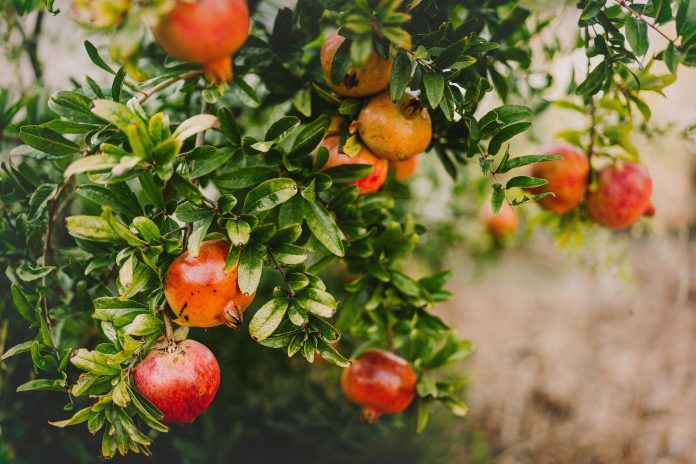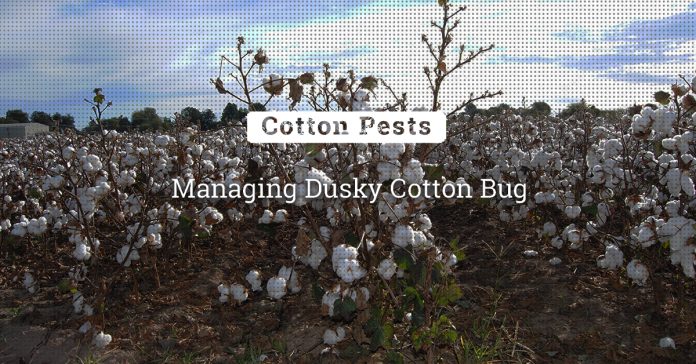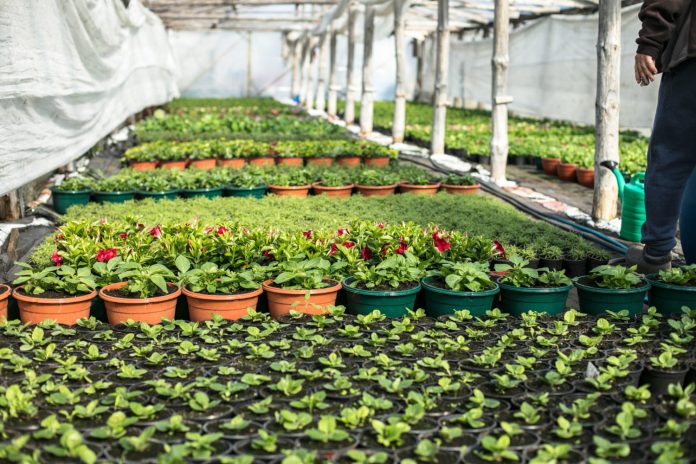Papaya (Carica papaya) is a tropical fruit that is commercially significant due to its exceptional nutritional and medicinal value. One of the most interesting aspects of papaya trees is their unique sexual characteristics and the nature of their flowering. Unlike most other fruit trees, papaya trees are able to change their sex and produce both male and female flowers at different stages of their development. Papaya plants/trees may be categorized to male, female or hermaphrodite trees based on type of flowers they produce. Depending on the tree’s type, the flowers and fruit (if found) vary in appearance, function and size. Typically, a papaya plant’s gender may change depending on the temperature during the developmental stages.
Papaya Trees – Male type
The flowers of male papaya trees are small which grow in clusters on long stalks (peduncle) and have a thin, tube-like structure. Unlike female flowers, which only contain a pistil, male flowers have both male and female reproductive organs, with stamens producing pollen and pistils not functioning for fruit production.
Under normal conditions, male papaya trees cannot produce fruit. However, in certain environmental conditions, such as high temperatures in the summer, the tree may undergo a temporary gender change, becoming a hermaphrodite. In this case, the previously non-functional pistil can become active, allowing the tree to produce fruit after pollination.

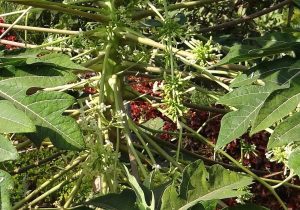
Papaya Trees – Female type
The flowers of female papaya trees grow singly or in small clusters and are typically larger than male flowers. They develop on shorter stalks and have a distinctive bulbous base that contains the ovary, which develops into the fruit when fertilized. The petals (5 in number) of female papaya flowers are broad and thick. Even though the male reproductive organ (stamen) is absent, the pistil is capable of producing fruit through pollination. Pollination is usually done by bees or other insects.
The fruit produced by pollinated female flowers is typically a green-skinned, melon-like fruit that ranges in size from 6 to 15 inches and contains yellow or orange flesh and black seeds. Unpollinated female papaya tree may produce seedless papaya fruit.

Papaya Trees –Hermaphrodite type
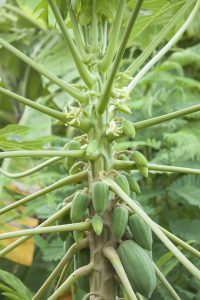
Hermaphrodite papaya trees are those that have both male and female reproductive organs in their flowers, making them capable of self-pollination and fruit production. Fruits produced from hermaphrodite papaya plants are generally medium to large in size, with an oval or elongated shape. They have a smooth, thin and slightly waxy skin that ranges in color from green to yellow orange when ripe and have a minimal number of small, black seeds.
During hot weather, hermaphrodite papaya trees may act as male trees, while under certain timing or training conditions, they may behave as female trees. this type of trees is preferred by commercial growers because they are more reliable and produce more fruit than female trees. However, they may require hand-pollination in some cases to ensure optimal fruit production.
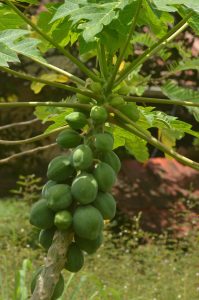

Causes of Flower dropping in Papaya trees:
-
Temperature and Relative Humidity (RH):
For optimal pollination and fertilization of papaya fruits, the temperature should ideally be between 20 to 33°C, while the RH should be between 70 to 85 percent. Any temperature or humidity levels either below or above this range can negatively impact the pollination process and result in flower dropping before the fruit is formed. In cases where the temperature is too low, chemical growth regulators can be used to compensate, but this may result in seedless or low-quality fruit.
-
Cultural Factors:
Cultural factors, such as inadequate or excessive nitrogen (N) fertility levels, can lead to flower dropping in papaya trees. Both low and high doses of nitrogen can cause this issue. Toxicity can have a direct effect on flower abortion. While even medium levels of ammonical nitrogen can affect flower and fruit settings. This can also trigger viral infections, leading to flower dropping.
-
Water management:
Papaya trees are sensitive to both flooding and drought. Insufficient and excess moisture can have adverse effects on flower development, pollination, fertilization and fruit setting in papaya trees. Uneven water supply to the papaya plants can induce stress, resulting in irregular flower production and fruit setting.
-
Light Exposure:
Reduced or increased duration of light exposure can have negative consequences, potentially affecting flower development, pollination, fertilization and fruit setting.
-
Wind:
Excessive wind can naturally result in physical damage to flowers, causing them to fall off and can also cause pollen to be swept away, potentially leading to inadequate pollination and fertilization.
-
Pests:
The damage caused by insects, especially those that feed on flowers or fruits, can negatively impact the health of papaya flowers. Chewing insects may also contribute to flower damage. Fruit flies are especially problematic and can cause premature flower droppings.
-
Diseases:
Fungal and bacterial diseases can affect flower development, leading to flower dropping. Viral infections can also cause flower and fruit drops, as the virus can affect the plant’s ability to develop and mature the flowers and fruits.
- Fungal infections: Powdery mildew, Downy mildew, Black spot.
- Bacterial infections: Bacterial spot, Speck disease.
- Viral infections: Papaya Ring spot infections, Leaf Curl viral infections etc.
-
Nutrient deficiency:
When the soil has poor water and nutrient holding capacities, nutrient deficiencies can occur, especially for micronutrients such as boron and calcium. This is particularly common in sandy and light soils.
Control Measures to prevent Papaya Flower Drop:
- The temperature and relative humidity are environmental factors that are often beyond the grower’s control. Similarly, the light exposure the trees receive cannot be controlled.
- In some cases, the only option for the grower is to wait for favorable weather conditions, while in extreme conditions, regulating irrigation practices can help to control the microclimatic conditions.
- To protect papaya plants from high winds, physical wind barriers can be erected along the borders, allowing necessary airflow while preventing damage from excessive wind.
- By monitoring disease and pest management, flower drops can be avoided, and maximum yield can be achieved in papaya cultivation.
- Ensure the papaya plants receive consistent and adequate watering, particularly during the flowering stage, to avoid water stress.
- Provide balanced fertilization and micronutrients to the papaya plants, as nutrient deficiencies or toxicity can cause flower drop.
- Ensure adequate pollination by introducing pollinators like honeybees, or hand-pollinate using a soft brush, as poor pollination can cause flower drops.
| Management | Products |
| Micronutrients |
(Use Shamrock Overseas Sluuurp wetting and spreading agent at 0.5 – 1 ml/lit of water) |
| Pests |
|
| Diseases | Fungal Diseases:
Bacterial Disease:
Viral Diseases:
|





